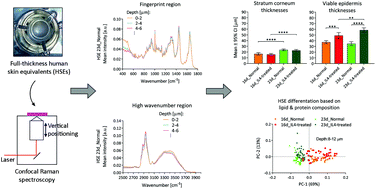Physical and compositional analysis of differently cultured 3D human skin equivalents by confocal Raman spectroscopy†
Abstract
Three-dimensional skin equivalents are increasingly gaining acceptance as non-animal based experimental models of human skin. They are particularly suited to studying differences in physical and compositional properties of normal and diseased skin and their impact on the skin's barrier function. Typically, a culture protocol yielding a model of normal skin is modified to create a model simulating a pathology. Skin layer thicknesses and lipid/protein contents are compared using methods that are invasive, precluding further experiments on the same replicates, and which may be prone to artefacts. We show here that confocal Raman spectroscopy (CRS) is a valuable method for non-invasive discrimination of skin equivalents grown under different culture conditions. Using 3D full-thickness skin equivalents developed in-house, we measure significant differences in stratum corneum and viable epidermis apparent thicknesses resulting from a 7-day difference in the cultures’ air-lift phase and from supplementation of the culture medium with interleukin 4. Furthermore, stratum corneum thicknesses obtained by CRS are up to 2.6-fold higher than values measured from histological photomicrographs. Regarding composition, CRS reveals the differential effects of the culture protocol modifications on ceramide, cholesterol and protein composition as a function of depth in the stratum corneum.

- This article is part of the themed collection: Analyst Recent HOT articles


 Please wait while we load your content...
Please wait while we load your content...